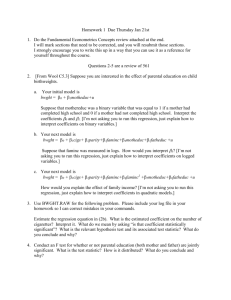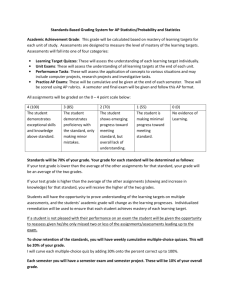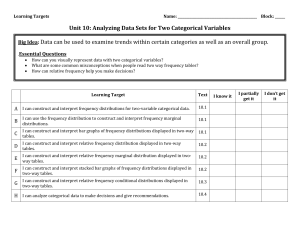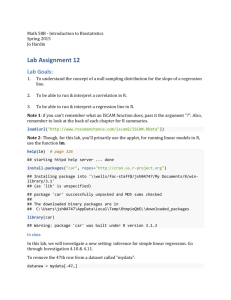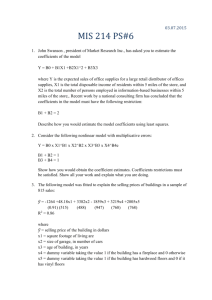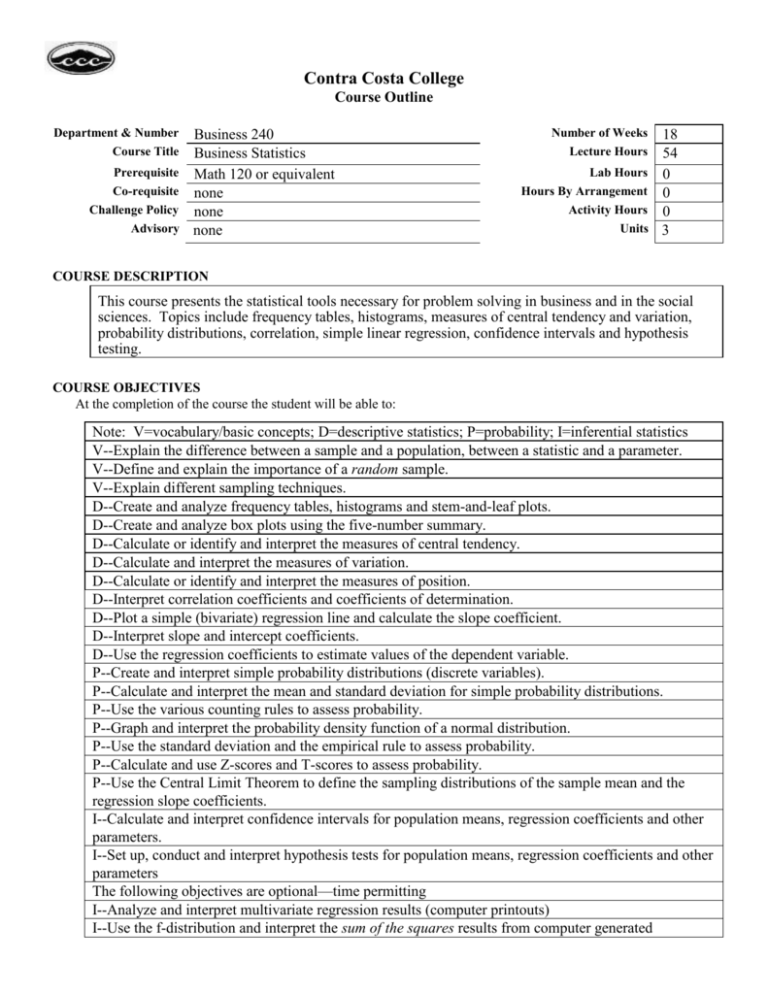
Contra Costa College
Course Outline
Department & Number
Course Title
Prerequisite
Co-requisite
Challenge Policy
Advisory
Business 240
Business Statistics
Math 120 or equivalent
none
none
none
Number of Weeks
Lecture Hours
Lab Hours
Hours By Arrangement
Activity Hours
Units
18
54
0
0
0
3
COURSE DESCRIPTION
This course presents the statistical tools necessary for problem solving in business and in the social
sciences. Topics include frequency tables, histograms, measures of central tendency and variation,
probability distributions, correlation, simple linear regression, confidence intervals and hypothesis
testing.
COURSE OBJECTIVES
At the completion of the course the student will be able to:
Note: V=vocabulary/basic concepts; D=descriptive statistics; P=probability; I=inferential statistics
V--Explain the difference between a sample and a population, between a statistic and a parameter.
V--Define and explain the importance of a random sample.
V--Explain different sampling techniques.
D--Create and analyze frequency tables, histograms and stem-and-leaf plots.
D--Create and analyze box plots using the five-number summary.
D--Calculate or identify and interpret the measures of central tendency.
D--Calculate and interpret the measures of variation.
D--Calculate or identify and interpret the measures of position.
D--Interpret correlation coefficients and coefficients of determination.
D--Plot a simple (bivariate) regression line and calculate the slope coefficient.
D--Interpret slope and intercept coefficients.
D--Use the regression coefficients to estimate values of the dependent variable.
P--Create and interpret simple probability distributions (discrete variables).
P--Calculate and interpret the mean and standard deviation for simple probability distributions.
P--Use the various counting rules to assess probability.
P--Graph and interpret the probability density function of a normal distribution.
P--Use the standard deviation and the empirical rule to assess probability.
P--Calculate and use Z-scores and T-scores to assess probability.
P--Use the Central Limit Theorem to define the sampling distributions of the sample mean and the
regression slope coefficients.
I--Calculate and interpret confidence intervals for population means, regression coefficients and other
parameters.
I--Set up, conduct and interpret hypothesis tests for population means, regression coefficients and other
parameters
The following objectives are optional—time permitting
I--Analyze and interpret multivariate regression results (computer printouts)
I--Use the f-distribution and interpret the sum of the squares results from computer generated
regressions.
I--Use the chi-square distribution to conduct goodness-of-fit tests and tests of independence.
COURSE CONTENT: (See course objectives for a detailed breakdown of the following topics.)
5
10
15
10
15
10
15
20
%
%
%
%
%
%
%
%
Basic vocabulary and key concepts
Descriptive statistics—univariate
Descriptive statistics—multivariate (regressions and correlations)
Probability and random variables
Probability distributions and properties (Normal, standard normal, t, F, Chi square)
The Central Limit Theorem and sampling distributions
Confidence intervals, univariate and multivariate (regressions, correlations, other)
Hypothesis testing, univariate and multivariate (regressions, correlations, other)
METHODS OF INSTRUCTION
Lecture with demonstrations of problem solving techniques. Lectures are supplemented with
worksheets that are completed in class to help students learn the material.
INSTRUCTIONAL MATERIALS
Textbook Title:
Author:
Publisher:
Edition/Date:
Fundamentals of Statistics
Michael Sullivan, III
Pearson/Prentice Hall
2nd edition, 2007
COURSE EXPECTATIONS (Use applicable expectations)
Outside of Class Weekly Assignments
Reading and studying
Problem solving practice
Homework sets (to turn in)
Hours per week
2
2
2
STUDENT EVALUATION: (Show percentage breakdown for evaluation instruments)
85
15
%
%
Exams
Homework
GRADING POLICY (Choose LG, CR/NC, or SC)
Letter Grade
Credit / No Credit
90% - 100% = A
80% - 89% = B
70% - 79% = C
60% - 69% = D
Below 60% = F
70% and above = Credit
Below 70% = No Credit
Prepared by:
Course New/Revision Date:
Course Effective Date:
X
Student Choice
Letter Grade
Or
Credit/No Credit
(which see, to the left)
Wendy Williams
Spring 2008
Fall, 2008


